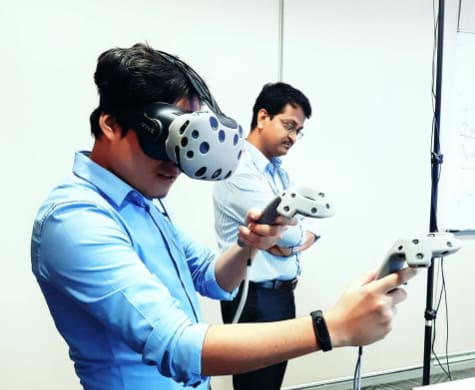What is the next big thing for digital technology in construction?
Lots of tech has been on the radar for the past few years, such as machine learning, artificial intelligence and the Internet of Things (IoT), which hasn’t quite hit the mainstream in construction because the software and hardware haven’t quite reached maturity. We will see these come to market in the near future.
There will be a trend for different new technologies coming together to reinforce each other’s capabilities and so radically alter the industry. Immersive technology, additive printing and deep learning and AI will enable us to view data better, and create more complex architectural forms with more complicated and efficient structures.
What role will BIM play in all of this?
Deep learning and AI require large amounts of data in the background to help the software learn and improve its analysis and decision making. BIM is all about the use of consistent data that works through a project from start to finish, which can feed into it.
BIM will help us organise and exploit data from the thousands of IoT devices the will be embedded in buildings. Experts at Aecom are currently looking at the use of sensor data and how we tie it into building systems and FM management.
Everyone is talking about the potential impact of AI on work and society, how do you see it being applied in construction?
I see great potential in the deep learning side of AI, and software being able to crunch huge amounts of data to propose more efficient designs.
For example, software is already available that uses figures on loadings on structures to propose numerous refined designs with optimised geometry and strength with minimal use of material. When these parts are also 3D printed on sites, the technology will reach its full potential.
Aecom is pioneering in its use of immersive technology, such as virtual and augmented reality, what’s the latest?
Microsoft HoloLens immersive technology during was deployed effectively during design development for the Serpentine Gallery pavilion, for the second year running. The architect and structural engineers used headsets to walk around and interact with the model and have discussions about the space and context without relying solely on the traditional drawings.

The client for a major UK infrastructure project has just engaged us to produce large scale VR environments to assist with stakeholder engagement. It is a large and very sensitive site, in terms of culture and heritage, and VR will help communicate to the public and other stakeholders precisely what the scheme will look like.
The ability to freely navigate a project in 3D is much more effective than traditional video or photo montages, which often received the criticism “well you just picked that view to show us the project in its best possible light”. The plan is to deploy HTC Vive head mounted displays, as well as more portable solutions such as the Samsung Gear VR.
Will VR become business as usual in the near future?
Yes, certainly in terms of project stakeholder engagement. if you show someone a flyer for a planned development, most of the time it goes into the bin, and if you put up posters people walk right past them.
But put someone into a VR headset, even if it’s only for 20 seconds, and they are plunged into the context of the project and able to experience it more directly than with any other medium.
VR is becoming an important tool to engage clients in the design process. Last week we were showing clients a VR model for a section of a proposed new airport to demonstrate the capabilities of the software. The experience was so powerful, it kicked off an impromptu design meeting as they tested out the sight lines for kiosks and departure boards.
Could this increased level of engagement transform the design process?
Yes. At present the client typically issues a brief and the architect, engineers etc interpret it to the point where they feel they have enough of a design to show the client. But VR brings the end goal of the project to the forefront, allowing the client to experience the building and suggest changes early in the decision making process.
How will immersive technology evolve over the next few years?
The resolution and field of view will improve, headsets will become lighter, smaller and there will be less equipment required to track the user’s physical movement.
I like to think of it in terms of the development of mobile phones, from first generation brick-sized handsets introduced in the 1980s to the latest smart phones. Current immersive headsets, like Oculus Rift and HTC Vive, are the first generation of VR, and given the fact that technology move much faster today, devices could look radically different very soon.
Chris Thorn is principal technology & process consultant at Aecom

Immersive technology, additive printing and deep learning and AI will enable us to view data better, and create more complex architectural forms with more complicated and efficient structures.– Chris Thorn, Aecom
Comments
Comments are closed.














Hi
Would love to see some videos of this in practice. We are a large social housing provider in South Wales and want to interact with our tenants through VR and BIM and monitor performance of appliances through IOT.
We are currently exploring these possibilities.
Thanks,
Christian